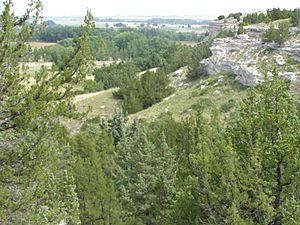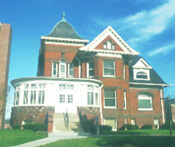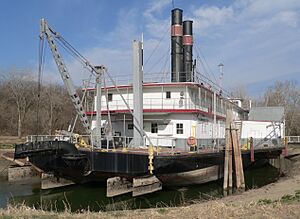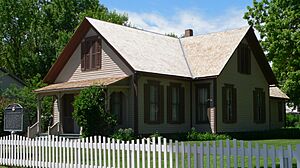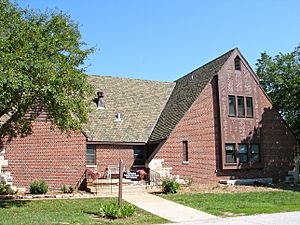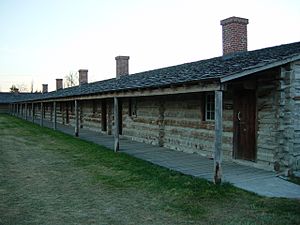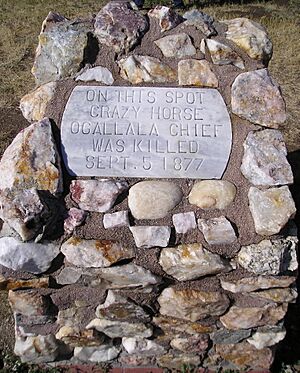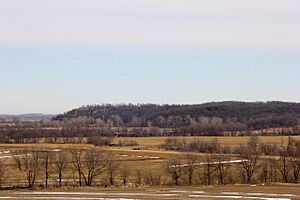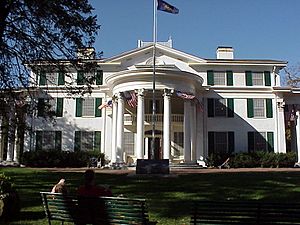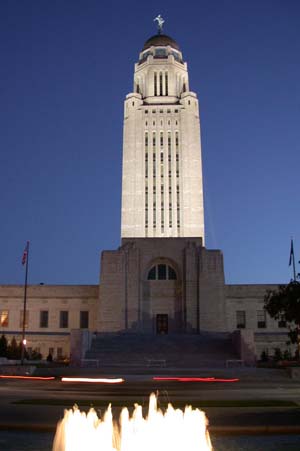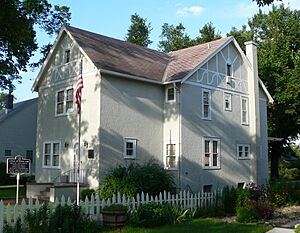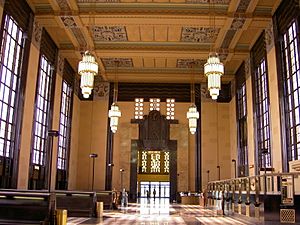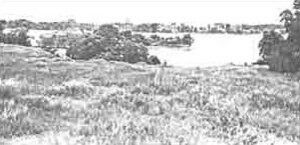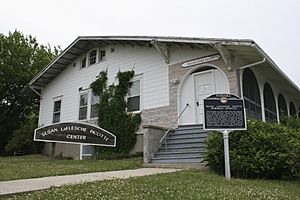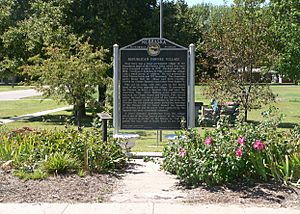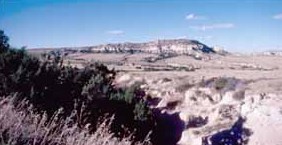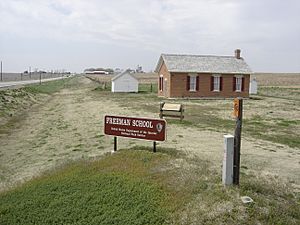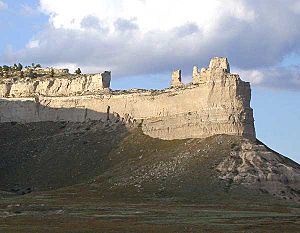List of National Historic Landmarks in Nebraska facts for kids
Nebraska is home to many special places that are important to American history! These places are called National Historic Landmarks (NHLs). They are chosen by the U.S. government because they tell amazing stories about our country's past.
There are 22 National Historic Landmarks in Nebraska. They are spread out across 18 of Nebraska's 93 counties. Let's explore some of these cool spots!
Contents
- Cool Historic Places in Nebraska
- Ash Hollow Cave
- William Jennings Bryan House
- Captain Meriwether Lewis (dustpan dredge)
- Willa Cather House
- Coufal Site
- Father Flanagan's Boys' Home
- Fort Atkinson
- Fort Robinson and Red Cloud Agency
- USS Hazard (minesweeper)
- Leary Site
- J. Sterling Morton House
- Nebraska State Capitol
- George W. Norris House
- Omaha Union Station
- Palmer Site
- Dr. Susan LaFlesche Picotte Memorial Hospital
- Pike Pawnee Village Site
- Robidoux Pass
- Schultz Site
- Scout's Rest Ranch
- Signal Butte
- Walker Gilmore Site
- Special Historic Places in National Parks
- See also
Cool Historic Places in Nebraska
Ash Hollow Cave
Ash Hollow Cave is a really old archaeological site near Lewellen. It's part of the Ash Hollow State Historical Park. This place helps us learn about ancient people who lived here long, long ago. It was named a landmark on July 19, 1964.
William Jennings Bryan House
This house in Lincoln was once the home of William Jennings Bryan. He was a very famous American politician and speaker. He ran for president three times! His house became a landmark on November 6, 1963.
Captain Meriwether Lewis (dustpan dredge)
The Captain Meriwether Lewis is a special type of boat called a dustpan dredge. It's located in Brownville. This boat helped keep rivers clear for other boats to travel. It was made a landmark on April 11, 1989.
Willa Cather House
The Willa Cather House in Red Cloud was the childhood home of famous author Willa Cather. She wrote many books about life on the American prairie. This house became a landmark on November 11, 1971.
Coufal Site
The Coufal Site near Cotesfield is an important archaeological site. It helps scientists understand ancient cultures in Nebraska. It was designated a landmark on July 19, 1964.
Father Flanagan's Boys' Home
This landmark in Boys Town is the original site of Father Flanagan's home for boys. He started a famous organization called Boys Town to help children in need. It became a landmark on February 4, 1985.
Fort Atkinson
Fort Atkinson is located in Fort Calhoun. It was an important U.S. Army fort in the early 1800s. It was also the site of the original Council Bluff. This fort was made a landmark on July 4, 1961.
Fort Robinson and Red Cloud Agency
Fort Robinson near Crawford was a U.S. Army post during the Indian Wars. It played a big role in the history of the American West. It became a landmark on December 19, 1960.
USS Hazard (minesweeper)
The USS Hazard is a special ship called a minesweeper. It's located in Omaha at Freedom Park. This ship helped clear dangerous mines from the ocean during wartime. It was designated a landmark on January 14, 1986.
Leary Site
The Leary Site near Rulo is another important archaeological site. It gives us clues about the people who lived in this area many centuries ago. It became a landmark on July 19, 1964.
J. Sterling Morton House
This house in Nebraska City was the home of J. Sterling Morton. He was the founder of Arbor Day, a holiday where people plant trees. It was made a landmark on May 15, 1975.
Nebraska State Capitol
The Nebraska State Capitol building in Lincoln is where the state government of Nebraska works. It's a beautiful and important building. It became a landmark on January 7, 1976.
George W. Norris House
The George W. Norris House in McCook was the home of U.S. Senator George W. Norris. He was a very influential senator who worked for many important changes in the U.S. It was designated a landmark on May 28, 1967.
Omaha Union Station
Omaha Union Station in Omaha was once a busy train station. It's a great example of old train station architecture. It became a landmark on December 23, 2016.
Palmer Site
The Palmer Site near Palmer is an archaeological site that spans two counties, Howard and Merrick. It's another place where scientists learn about ancient life in Nebraska. It was made a landmark on July 19, 1964.
Dr. Susan LaFlesche Picotte Memorial Hospital
This hospital in Walthill was founded by Susan La Flesche Picotte. She was the very first American Indian physician and one of the first female doctors in the U.S.! It became a landmark on April 19, 1993.
Pike Pawnee Village Site
The Pike Pawnee Village Site near Guide Rock is where Captain Zebulon Pike claimed the area for the U.S. in 1806 during his expedition. It was designated a landmark on July 19, 1964.
Robidoux Pass
Robidoux Pass near Gering was an important part of the Oregon Trail. Many pioneers traveled through this pass on their way west between 1848 and 1851. It was made a landmark on January 20, 1961.
Schultz Site
The Schultz Site near North Loup is another archaeological site. It helps us understand the history of early human settlements in the region. It became a landmark on July 19, 1964.
Scout's Rest Ranch
Scout's Rest Ranch, also known as Buffalo Bill Ranch, is located northwest of North Platte. This was the home of the famous showman Buffalo Bill Cody. It was designated a landmark on January 13, 2021.
Signal Butte
Signal Butte near Gering is a significant archaeological site. It provides important information about prehistoric cultures in Nebraska. It was made a landmark on January 20, 1961.
Walker Gilmore Site
The Walker Gilmore Site near Murray is an archaeological site. It helps researchers learn about ancient communities that lived in the area. It became a landmark on July 19, 1964.
Special Historic Places in National Parks
Some historic places are so important that they are already part of the National Park System. This means they are already highly protected. Nebraska has two of these special places:
- Homestead National Historical Park
This park near Beatrice protects the site of the very first land claim made under the Homestead Act of 1862. This act allowed people to get free land if they lived on it and farmed it. It was established on March 19, 1936.
- Scotts Bluff National Monument
Scotts Bluff near Gering is a famous landmark that pioneers saw on the Oregon Trail and Mormon Trail. It was a sign that they were getting closer to their destinations. It was established on December 12, 1919.
See also


